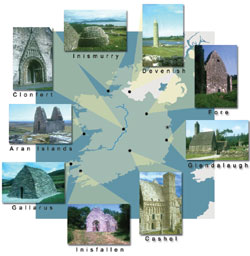| |
The
Introduction of Stone Construction | Irish Architecture
in the Early Middle Ages: c. 500-1200 AD
Professor Roger Stalley

|
 |
|
 |
One
of the most fundamental changes that took place in Irish
church architecture was the introduction of stone as the
primary building material. The development of stone building
was a slow process but also reflected the growing size
and wealth of the communities. Resistance to the use of
stone might be seen as a preference for the more plentiful
and easily worked wood as well as continued veneration
of existing wooden buildings that accrued value through
use and tradition. Contrary to the prevailing impression,
the stone church - or 'daimhliag' - was not fireproof,
since such buildings were generally covered by timber-framed
roofs. The occasional stone church existed in the pre-Viking
period: there was one at Duleek in the 7th century and
another at Armagh in 789. Outside major centers like Kells
and Armagh, however, they remained rare until the 10th
century. It may be significant that the first stone church
recorded in the annals was built at Armagh, the monastery
which claimed to be the centre of Christian Ireland. The
development of stone building probably evolved through
a desire for greater status and prestige but also relied
on the growing size and wealth of the community. Further,
stone buildings were more durable and, if not completely
immune from the ravages of fire due to continued use of
wooden roofs, there was certainly some improvement in
the safety and reliability of the structures. |
The common
characteristics of stone churches in major monasteries may
be assessed according to a variety of criteria, including:
Single cell structures, often with a length to breadth ratio
of 3:
 |


Ireland,
Fore, St. Fechin, Ground plan
 |
 |


Ireland,
Fore, St. Fechin, Exterior view
 |
 |


reland,
Glendalough, Cathedral, Ground plan
 |
 |


Ireland,
Glendalough, Cathedral

|
 |


Ireland,
Kilmalkedar, Church

|
 |
The
north and south walls frequently continue slightly beyond
the corners to form 'antae' supporting the roof timber,
which originally overhung the gable wall. Roofing systems
and the use of shingles fitted over a timber frame.
|
Window design and the problem of glazing offers another point
of interest. Windows tend to be very small, their heads either
triangular or round-headed. In the latter case they are often
cut from a single stone, rather than constructed as a genuine
arch. There is no evidence, either from documentary or archaeological
indications, for the use of glass but, given its use in Anglo-Saxon
England, it is hard to believe that it was unknown in Ireland.
At the very least wooden shutters must have been essential in
adverse weather.
The west wall of the early churches invariably contained a lintelled
doorway with inclined jambs, framed in some cases by an 'architrave'
band projecting from the surface in thin relief. Though deceptively
simple in form, the doorways are built of well-dressed stone,
robust and imposing in appearance. Fine examples are found at
Fore, St. Fechin's and St. Mary's Church at Glendalough. In
time, increasingly elaborate portals appear at Cashel, one of
the first Irish buildings to be enhanced with decorative sculpture
and at Clonfert, designed with a steep decorative "tangent"
gable.
 |


Ireland,
Fore, St. Fechin, Exterior view
 |
 |


Ireland,
Glendalough, St. Mary's Church, Doorway
 |
 |


Ireland,
Cashel, Cormac's Chapel, Doorway
 |
 |


Ireland,
Clonfert. Cathedral, Doorway

|
Types of
masonry: The quality of the rubble masonry found in the early
churches is often very high. When stones of different color
and texture are neatly fitted together, as in the so-called
'Men's Church' on Inismurray, the visual effect can be highly
attractive. The actual character of the masonry varies a great
deal, in part reflecting local geological circumstances. There
is some evidence that the walls of early churches were covered
by lime plaster, traces of which have been discovered at Clonmacnois
Cathedral.
briefing
| image index | resources
home page | site
image index | site resources
media center for art history, archaeology
and historic preservation | columbia
university
|
|

